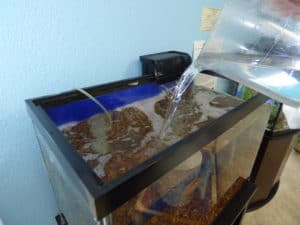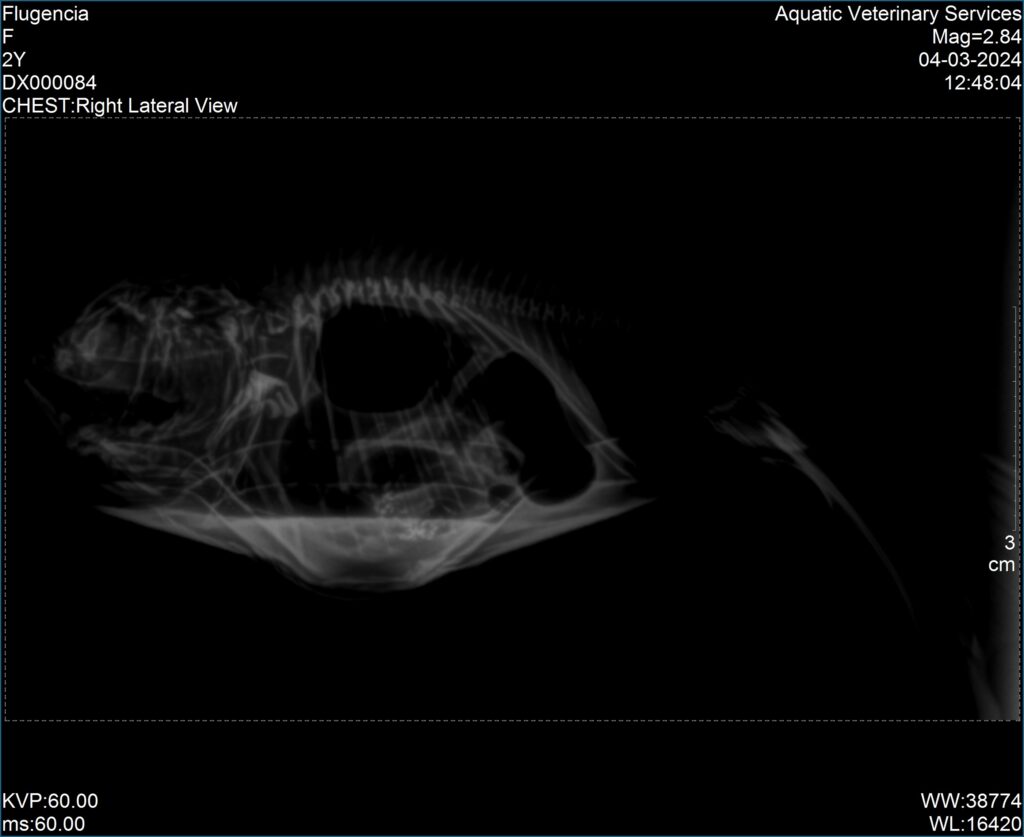** This post contains affiliate links where we receive a small percentage of your purchase based on our recommendations. **
If your fish is presenting any physical or behavioral signs of illness, don’t wait around for them to magically get better! Follow these steps for the best chance to save your sick fish.
Step 1: Check Your Water Quality
Poor water quality is the #1 cause of illness and disease in fish. Like the air we breathe, the water a fish swims in is critical to good health. Use a liquid-based test kit, not those silly strips, and see if your parameters fall within the following ranges. For those species not listed, we recommend looking up their parameters here.
Goldfish (indoors & outdoors)
| Parameter | Range |
| Ammonia | ≤ 0.1 mg/L (ppm) |
| Nitrite | 0 mg/L |
| Nitrate | < 20 mg/L |
| pH | 6.5-9.0 |
| KH (alkalinity) | > 100 mg/L |
| GH (hardness) | > 100 mg/L |
| Temperature | 32-85F (0-29C) |
Koi
| Parameter | Range |
| Ammonia | ≤ 0.1 mg/L (ppm) |
| Nitrite | 0 mg/L |
| Nitrate | < 20 mg/L |
| pH | 6.5-9.0 |
| KH (alkalinity) | > 100 mg/L |
| GH (hardness) | > 100 mg/L |
| Temperature | 32-85F (0-29C) |
Betta
| Parameter | Range |
| Ammonia | ≤ 0.1 mg/L (ppm) |
| Nitrite | 0 mg/L |
| Nitrate | < 20 mg/L |
| pH | 7.0-8.5 |
| KH (alkalinity) | > 100 mg/L |
| GH (hardness) | > 100 mg/L |
| Temperature | 78-82F (25-28C) |
General Tropicals
| Parameter | Range |
| Ammonia | ≤ 0.1 mg/L (ppm) |
| Nitrite | 0 mg/L |
| Nitrate | < 20 mg/L |
| pH | 7.0-8.5 |
| KH (alkalinity) | > 100 mg/L |
| GH (hardness) | > 100 mg/L |
| Temperature | 78-82F (25-28C) |
Please keep in mind these are general guidelines – not all fish read the book! If your parameters are slightly off from these and have been for a long time, your fish are likely adapted to these levels. Adding new fish, however, will not be safe.
Step 2: Fix Your Water Quality
If your ammonia, nitrite or nitrate are too high, such as those tanks undergoing New Tank Syndrome, you can take immediate steps to fix this. Chronic stress causes a decreased immune function, keeping your sick fish ill. If you are repeatedly replacing your filter media, you are resetting your biological filtration which keeps your nitrogen cycle running! We know it says so on the box, but stop replacing your filter media. This is how the filter companies make more money, not keeping your fish healthy.
If your pH or temperature is out of range, DO NOT MAKE FAST CORRECTIONS. This will cause your sick fish to DIE. This is the case for Old Tank Syndrome and fish in temporary holding tanks during deep cleanings.
In order to correct issues with pH and/or temperature, make very small changes over days to weeks to ensure your fish will survive. We’re talking less than 10% on a daily basis. Please check your source water pH and KH levels to ensure they are high enough to keep your fish happy. If you have a lot of large fish, they will put a ton of stress on your environment, so you may need extra insurance.
Most of the time, these two steps will take care of most fish issues.

Step 3: Check Your Fishes’ Food
Is that the same container of food you bought when you brought your fish home 2 years ago? Chances are your fish hasn’t been getting enough vitamins in order to have a healthy immune function. Once you open ANY type of fish food container, you have 6 months to feed it out and then TOSS IT. For flake foods, you’re looking at only 3 months total due to the increased surface to mass ratio. Another key point: most bettas will never finish a full container of betta food.
Be sure to properly store your fish’s food in an airtight container in a cool, dark area of your home. Never store fish food outside! Every time you open that container, water soluble vitamins, specifically vitamins C and B, are lost to evaporation. This will cause your fish’s food to decrease in nutrition over time. Soaking your fishes’ food will cause significant vitamin loss and is never recommended. Some sick fish have issues with food texture, so try to vary their diet with pellets, gel, live foods or meats/veggies to support them during their illness.

Step 4: Call Your Veterinarian About Your Sick Fish
Sure, you could go to the pet/koi store and buy a bunch of medications that might work on your sick fish, or you can get to the bottom of your fishes’ disease and get them treated quickly. Yes, a specialty veterinarian, especially a house call one, is a premium service and can carry a larger price tag. We wish more veterinary schools taught their students enough to handle fish properly. But wasting time on worthless OTC medications can make the problem worse before your veterinarian gets there.
The best bet to help your sick fish fast is to call your veterinarian as soon as you notice something amiss. They may be able to help you work through the above steps and fix your fish without any additional intervention.
To find a fish veterinarian, follow these steps.



Omg my fish hides behind its plant and just sits there but the other one swims around I am scared
For veterinary assistance, please visit https://fishvets.org or https://wavma.org to find an aquatic veterinarian near you.
Sick fish
Loss of appetite.
Weakness or listlessness.
Loss of balance or buoyancy control, floating upside down, or ‘sitting’ on the tank floor (most fish are normally only slightly negatively-buoyant and it takes little effort to maintain position in the water column)
Erratic/spiral swimming or shimmying.
shobokan fish has trouble swimming upright and twirls in circles. I have stopped feeding for 2 days a day then feeding frozen peas. It’s still having problems.
If you are concerned about your fish, please call (831) 278-1081 for veterinary assistance. If you are outside California and Nevada, please visit https://fishvets.org or https://wavma.org
Hi my fish is betta female is laying on side now. Almost upside down she is still alive but looks Very sick. My kid Savannah got it from pet smart in newburgh NY. She named her christine. What’s wrong with her fish?
If you are concerned about your fish, please call (831) 278-1081 for veterinary assistance. If you are outside California and Nevada, please visit https://fishvets.org or https://wavma.org
My fish is doing catvill again and again in water and is lying still in water pls tell an idea so that she can survive.I need an idea urgent and also she is not eating fish food I need idea today
If you are concerned about your fish, please call (831) 278-1081 for veterinary assistance. If you are outside California and Nevada, please visit https://fishvets.org or https://wavma.org
My fish is sick but l remove it out of the others how can l treat it cus l dnt want it to die
If you are concerned about your fish, please call (831) 278-1081 for veterinary assistance. If you are outside California and Nevada, please visit https://fishvets.org or https://wavma.org
Pingback: How do you save a dying guppy – GlobeAqua
Pingback: Top 10+ How To Know If A Fish Is Dying - GA Pet Sitters